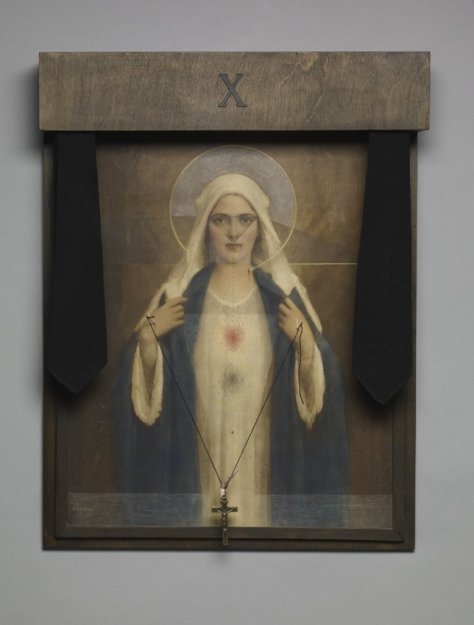Mapplethorpe was interested in identity and amongst his huge oeuvre he took multiple portraits, and many self portraits. He was gay, however he initially tried to bury this aspect of himself and conform, but eventually ended up making images that are highly charged, homoerotic in nature, that still have the power to shock, and, over the years, have often been banned from display.
Mapplethorpe grew up in the rebellious years, when the civil rights movement in America was active, gay liberation was starting, the birth-pill became available, and gay pornographic films became mainstream (Deep Throat). He was born into a middle-class family and was said to be a socially awkward teenager. Initially at college he was part of a right wing, strongly heterosexual group, but gradually became more interested in the counterculture movement, started using drugs and became interested in the Cubists and Surrealists. He also met Patti Smith who became a huge influence and support in his life. He initially made mixed media and collage artworks, often based on religious iconography (although with erotic overtones). He had been brought up Catholic, with all the colour, pomp and rituals of that faith.

He started photography using a Polaroid camera, initially possibly to make images that he could use in his collages, but then to make images of anything he was interested in, including his lover, flowers, china and odd bits of outdoor scenery. He took many of Patti Smith, but also others of himself in a range of situations. There is one very early series of Patti Don’t Touch Here showing her leaning against the wall, looking subdued and thoughtful, possibly taken by a very possessive friend/partner/lover. Many off the Polaroid images were snapshots, taken in the moment and for the moment. Speed of production was the thing.

Mapplethorpe took self-portraits throughout his career. They were often partially veiled or broken into fragments, he would hand colour parts of the images, and take his body from unusual angles. While he was a certainly free with the types of images he took, with much play acting there was only a limited amount of true self disclosure. In an interview in 1987 he said ‘I would never take a self-portrait when I was depressed…. I don’t want to see that part of me’ (Wolf, 2019). Does all the highly explicit imagery do as much to conceal as to show?
As well as continuing to take homoerotic images mainly of the gay, male s/m community, (which he was an active and enthusiastic part of) Mapplethorpe also circulated in the art and culture high society, taking a series of portraits of the rich and famous, film stars and artists. He excelled in showing their hidden personality. Mapplethorpe was interested in art history and collected photographs by a range of people, including Julia Margaret Cameron and Minor White. He often used these interests to inform his photography, posing people to replicate statues or earlier art works, such as James Ford in his bathtub – like the Death of Marat painting by Jaqueline-Louis David. He also continued to photograph still life images, often showing them in elaborate frames. He moved to using a Hasselblad with its square format and increased clarity, while taking more images of the famous, posed against neutral backgrounds. He had moved from the immediacy of the Polaroid images to producing perfection in gelatin silver prints.

His work became famous and was regularly shown all over the world. He also produced books and limited run portfolios. Many of his exhibitions were contentious, and some were cancelled as being ‘pornographic’ (which they undoubtedly were) – although this raises the ongoing question about whether pornography and art are mutually exclusive. Can they be? And indeed, should they be? Where is the boundary and what side are many of Mapplethorpe’s images on?
Mapplethorpe kept careful control of his work, and, although he did not produce prints himself, was heavily involved in what they looked like, and how many of each edition should be offered. Many of his images were never printed for sale. He was fascinated by symmetry, form and geometry – which the square format of the Hasselblad lent itself to. However, he did not just take nudes, he also took a wide range of portraits and still life images. He always looked for perfection. Something different – he said in 1978 “I want the person to look at least as interesting as they can look… I try to catch something unique in him that no one else has” (Mapplethorpe, 1978, quoted in Robert Mapplethorpe, The Photographs, p57).
Mapplethorpe contracted AIDS and died in 1989, setting up The Robert Mapplethorpe Foundation just before he died. Prior to his death he continued to work intensively but concentrated more on still life images of flowers and sculptures. His images remain a fascinating legacy of a complex man.
References and Sources:
Hartley, K. and National Galleries Of Scotland (2006). Robert Mapplethorpe -National Galleries of Scotland to accompany the exhibition Robert Mapplethorpe held in the Scottish National Gallery of Modern Art, Edinburgh, from 29 July to 5 November 2006. Edinburgh Scottish National Gallery Of Modern Art.
Mapplethorpe, R., Martineau, P., Salvesen, B., Gefter, P., Katz, J.D., Linkof, R., Meyer, R., Squiers, C., Getty, P., County, A. and Musée Des Beaux-Arts De Montréal (2016). Robert Mapplethorpe: The Photographs. Los Angeles, Calif.: J. Paul Getty Museum.
National Galleries of Scotland. (2019). ARTIST ROOMS Self Evidence | Photographs by Woodman, Arbus and Mapplethorpe. [online] Available at: https://www.nationalgalleries.org/exhibition/artist-rooms-self-evidence-photographs-woodman-arbus-and-mapplethorpe [Accessed 26 Jul. 2019].
Wolf, S. (2019). Mapplethorpe – Polaroids. Prestel.
